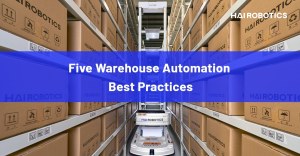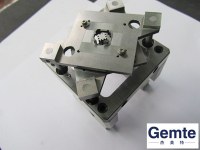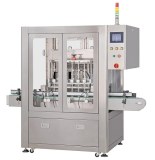To achieve the goals of labor savings, space savings, throughput and flexibility gains, and reduced maintenance and supervision, many companies are expecting to move forward with automation. In this article, we will talk about five of the warehouse automation best practices.
In recent years, COVID-19 has caused a booming online marketplace. Warehouse operations are one of the most important parts of the business for large and small e-commerce companies. To achieve the goals of labor savings, space savings, throughput and flexibility gains, and reduced maintenance and supervision, many companies are expecting to move forward with automation. Steps in the picking, packing, and shipping process can all be automated. Warehouse automation also reduces the chance of an error occurring and lets workers focus their attention on other areas. (Learn More: 12 Benefits of Warehouse Automation )
In this article, we will talk about five of the warehouse operations best practices .
five warehouse automation best practices
Use the right WMS ( Warehouse Management System ) to speed up processes and automate data collection
Regardless of which type of business you are doing, every company needs to know what is suitable for them and equip their business with the right tools. Warehouse Management System (WMS) is one such tool. WMS is a software that helps companies to manage and control the warehouse operations, such as in and outgoing inventory, picking/packing/shipping, and inventory replenishment. Companies that need to keep track of what's going on in warehouses and want to speed up processes can benefit from using a warehouse management system (WMS). WMS can collect real-time data from the automated storage and retrieval systems (AS/RS), regardless of the location. WMS often has real-time inventory tracking capabilities, which help staff know what's in stock and where it's located. Staff can see that a new order needs to be placed and do so in time to replenish inventory. Moreover, most warehouse agv automation systems can integrate with other software and automate manual tasks across the different supply chains for increased efficiency and productivity.
Use AGV (Automated Guided Vehicle) to reduce warehouse workers' travel time
Automated Guided Vehicle (AGV), known as self-guided and without an onboard driver, moves items around warehouse facilities using marked long lines or wires on the floor, or magnets, lasers, or vision cameras for navigation. AGV uses software programs to determine the vehicle's location, position, and movement within a warehouse. It can operate inbound and outbound handling, raw materials transportation, and some work-in-progress applications. Warehouse workers may travel above 10-20km (6-12 miles) per shift, but this condition can be eliminated by using Automated Guided Vehicle (AGV). With the use of AGVs, warehouse managers can remove workers from heavy-duty tasks and put them into more high-value activities.
Use AMR (Autonomous Mobile Robot) to enhance safety for workers
An autonomous mobile robot (AMR) is a type of robot that can move through its environment independently without a human directly controlling it. Many organizations use AMRs for tasks that would be harmful to or not possible for human workers. For example, they may be used to carry heavy loads in industrial environments, work in extremely cold storage warehouses, or where humans cannot be working. AMRs are able to autonomously navigate around obstacles and people on their path while setting up the best route to get to their destination. Using AMR to transport pallets or goods, without human interaction, can avoid collisions.
Use ACR (Autonomous Case-handling Robot) to improve warehouse operational efficiency, storage density, and flexibility
Autonomous Case-handling Robots (ACR) are autonomous robots that can take part in the goods-to-person (G2P) automation model. They are a hybrid between AMRs and grown moving vehicles with a shuttle-type retrieval function to handle totes from static shelving. Such autonomous robots in warehouses can increase operational efficiency by 300% to 400% and density by 80-400%, and enable customers to get literally 99.9% picking accuracy.
Autonomous case-handling robots help warehouse owners to maximize the space that they have. For one thing, you don't need to send people off into the aisles by using ACRs to handle product retrieval and storage. This means that you can install your product shelves with smaller aisles, which creates more room for storage. Second, ACRs can maximumly utilize vertical space. A lot of traditional technologies, especially manual ones, are limited by human heights. ACRs enable storage heights of up to 10m (32.8 feet), optimizing the storage space in a warehouse up to 4 times compared to a manual warehouse, providing more space for more items. Hai Robotics HaiPick A42T Telescopic ACR is the world's first ACR that can pick up and store plastic totes and carton boxes at a dizzying height of up to 10m (32.8 feet). By automating to the top of the ceiling, there is no longer a bunch of waste vertical space.
ACRs are powered by intelligent software that allows robots to accurately pick the right item faster compared to manual picking, significantly improving picking accuracy by up to 99.9%. The operators do not need to spend time finding the right totes. The robots bring only the required totes, and if possible, a schedule is arranged so that each tote can fulfill multiple orders. With a carrying capacity of up to 9 totes and advanced path planning algorithms, ACRs can achieve unprecedented high efficiency of 3-4 times (per worker) higher than manual labor.
Business changes quickly, and flexibility is always crucial for any business. The construction of a traditional automation system can sometimes take a year or more to implement and go-live, and it is nearly impossible to move to another warehouse once built. One significant advantage of ACR systems is that it can be easily removed to another location. Operators find ACRs appealing because there is an in-built ability to adapt to most environments. The flexibility of ACR systems makes it easier to deploy and transform.
Automate in stages. You do not need to fully automate all at one time.
Advancing a manual warehouse to a fully automated facility all at one time will likely cause unnecessary disruption for both workers and managment as there may be too many new processes and technologies for employees to learn to use confidently at the same time. It's wiser to slowly upgrade the warehouse step by step, rather than upgrade everything at once. Introduce new technology in stages, gives employees time to adjust to new processes and gain confidence in their new skills before introducing the next stage of facility advancement.
If you want to know more kinds of robotic products, please visit our website.
Localisation : No. 99, Gushu 2nd Road, Nanchang Community, Xixiang Subdistrict, Baoan District, Shenzhen, China, 518126 Shenzhen,
Personne à contacter : hai robotics , 0086 755 23208112








